Pros
Cons
Introduction
Overall Design
{{section_header}}{{section.name}}{{/section_header}}
The Samsung UN46C7100 is a very good looking TV. The incredibly thin frame, discreet bezel, and brushed aluminum finish make for a real looker, especially compared to the legion of piano black rectangles that permeate most of the market. The four-legged stand on the C8000 and C9000 series help further define Samsung the design leader home theater right now, and are worth looking into if you're trying to spice it up in the living room.
Front
{{section_header}}{{section.name}}{{/section_header}}
The Samsung UN46C7100 has a beautiful, slim frame with as minimal a bezel as we've seen. Onboard controls are located along the bottom, designed as touch-sensitive buttons that leave fingerprints.

Back
{{section_header}}{{section.name}}{{/section_header}}
The Samsung UN46C7100 has all its ports on the back, arranged in an L-shape.

Sides
{{section_header}}{{section.name}}{{/section_header}}
The Samsung UN46C7100 is incredibly slim, as you can see in these photos. Some of the ports on the back face the side, but you can hardly see them here.

Stand/Mount
{{section_header}}{{section.name}}{{/section_header}}
The Samsung UN46C7100 has a wide, sturdy stand with a brushed aluminum finish. It feels heavy enough to secure the large TV panel, and allows the panel to swivel back and forth.

Remote Control
{{section_header}}{{section.name}}{{/section_header}}
The Samsung UN46C7100 has a very cool looking remote, but we were frustrated with the overall experience.

In the Box
{{section_header}}{{section.name}}{{/section_header}}
The Samsung UN46C7100 ships with the stand, remote control, batteries, instruction manual, assorted other documentation, and a whole series of adapters to fit into the strange, proprietary ports. And as a special bonus, the C7100 series also ships with two pairs of 3D glasses.
Black Level
{{section_header}}{{section.name}}{{/section_header}}
The Samsung UN46C7100 showed a strong performance in our black level test. Though it wasn't quite as good as the Sony HX800, it was identical to the Samsung C8000. None of these LCD displays could match the plasma Panasonic, which is the norm for televisions. More on how we test black level.
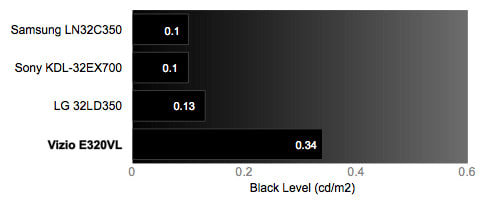
Peak Brightness
{{section_header}}{{section.name}}{{/section_header}}
The Samsung UN46C7100 had no problems with producing a bright enough picture. The peak brightness measured up with the best in its class. Only the Panasonic showed a problem with peak brightness, which was weak even for a plasma display. More on how we test peak brightness.
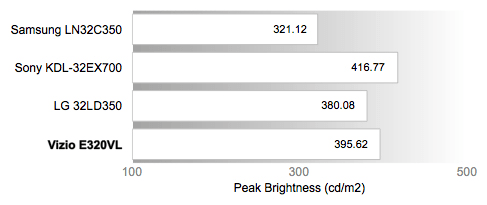
Contrast
{{section_header}}{{section.name}}{{/section_header}}
The Samsung UN46C7100 produced a contrast ratio of 4052:1, according to our tests. Of course, this is far less than the absurd 6,000,000:1 contrast that Samsung reports. The discrepancy is because we test the the black level and peak brightness under the same conditions, with the same menu settings. Manufacturers get their numbers by turning the backlight and brightness all the way up, taking the peak brightness measurement, then lowering the backlight and brightness, displaying an all-black screen, and taking the black level measurement. Since this in no way reflects how people actually watch a television, we reject that methodology and use our own. 4052:1 is good score. More on how we test contrast.

Tunnel Contrast
{{section_header}}{{section.name}}{{/section_header}}
The Samsung UN46C7100 showed a slight problem with maintaining a consistent black level. The test puts a large black rectangle on the screen, surrounded by a little white. Then black rectangle gets smaller and more white fills the screen. We can clearly see that the Samsung UN46C7100 is performing some kind of dynamic contrast adjustments. We turned off all the features that we could, but there's still some minor processing going on. The performance here is not anything to worry about, but an ideal performance would be a straight, horizontal line on the chart below. More on how we test tunnel contrast.
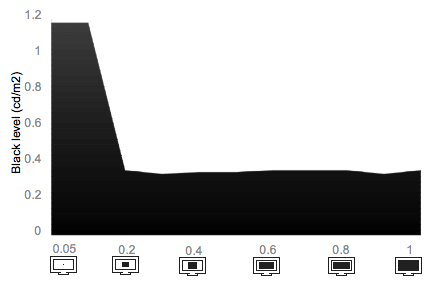
White Falloff
{{section_header}}{{section.name}}{{/section_header}}
The Samsung UN46C7100 had no problems with maintaining a consistent peak brightness, at least until the white test square was only 5% of the screen, surrounded by dark black. More on how we test white falloff.
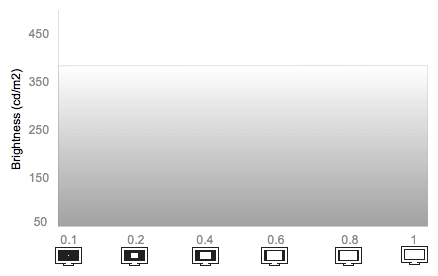
Uniformity
Greyscale Gamma
{{section_header}}{{section.name}}{{/section_header}}
The Samsung UN46C7100's greyscale gamma test shows how well the TV transitions from black to white. Overall, the performance could have been better, and we suspect that the dynamic contrast processing (those that we were not able to turn off) had a hand some of this.
Look at the chart below. The lower left hand corner represents the shadows. Because the line is partially horizontal instead of a smooth, upward slope, we can see that the UN46C7100's screen had some problems displaying shadow details. There's also the general slope of the curve to consider. An ideal slope is somewhere between 2.1 and 2.2. The Samsung's 2.71 performance is a bit steep, and indicates that it's probably missing a lot of the finer gradations in the greyscale spectrum. More on how we test greyscale gamma.
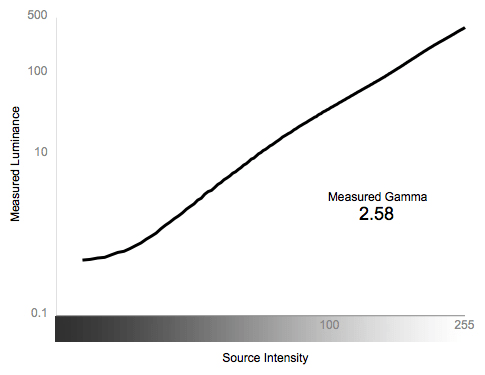
Color Temperature
{{section_header}}{{section.name}}{{/section_header}}
The Samsung UN46C7100 showed an excellent performance in maintaining a consistent color temperature. More on how we test color temperature.

RGB Curves
{{section_header}}{{section.name}}{{/section_header}}
The Samsung UN46C7100 did well in the RGB color curve test, which measures every possible value in the red, green, and blue channels. As you can see in the chart below, the response curves are relatively smooth. The blue channel is a little out of sync, darker than the reds and greens.The blue channel also peaks in the highlights, indicated by that horizontal portion of the line in the upper-right portion of the chart. Peaking means that the TV can't display any details after a certain brightness. Overall, we were pleased with the performance. More on how we test RGB curves.

The strips below are digital recreations of the performance charted above. We compare it to the ideal response curve, as well as three similar televisions.
Motion Performance
{{section_header}}{{section.name}}{{/section_header}}
Motion Smoothness (8.5)
The Samsung UN46C7100 was a strong performer in the motion tests, as most of the recent Samsung reviews. When we turned the motion processing features off, we saw the normal amount of flickering, trailing, and loss of fine detail, but certainly no more (and maybe even a little less) than most LCDs.
When the turn on the Auto Motion Plus feature, all of those issues seem to disappear. It's really quite remarkable how much fine detail the TV can recover. However, we strongly recommend that you leave this feature disabled, because (like all motion "improving" features) it makes your picture look weird. It's difficult to describe the effect, but it's readily apparent. Film-based content, in particular, takes on an overly-sharp look, like video instead of film. All the director's hard work goes straight down the tubes. Be a pal to Hollywood and leave it off.
Motion Artifacting (7.0)
The motion artifacting seen on the Samsung UN46C7100 was the same as almost any LCD TV: trailing, flickering, and loss of detail. When the Auto Motion Plus feature is engaged, additional artifacts are created. More on how we test motion performance.
3:2 Pulldown & 24fps
{{section_header}}{{section.name}}{{/section_header}}
The TV had no problems with displaying native 24fps content. In order to get the best performance without any jitters, set the Film Mode to Auto 1. More on how we test 3:2 pulldown and 24fps.
Resolution Scaling
{{section_header}}{{section.name}}{{/section_header}}
The Samsung UN46C7100 has a native 1080p (1920 x 1080) resolution, but most of the video you'll end up watching is likely to be of a lower resolution. It's up to the TV's processing to take that picture and scale to fit the screen. More on how we test resolution scaling.
480p
The Samsung UN46C7100 had no problems at all with 480p content.
720p
With 720p content, the Samsung UN46C7100 showed some slight tendency towards Moires with high frequency patterns.
1080i
With 1080i content, the Samsung UN46C7100 again showed Moire patterns in some high frequency patterns, but nothing that should disturb most kinds of subjects.
3D Effect & Experience
{{section_header}}{{section.name}}{{/section_header}}
We thought the 3D effect was pretty typical from a first-generation 3D HDTV. We saw sort of a shaky, jittery 3D effect during action scenes and a far more stable effect when there wasn't a lot of action going on. Moving objects tend to look juddery, like a noticeably low frame rate. The 3D effect dropped out every so often—more often if the subject was in the foreground—but not often enough to totally ruin the illusion. When things run past the screen, they flash in and out of 3D, which really doesn't look good. Other downsides include fast panning, which ruins the effect almost entirely, and fine details, which, due to crosstalk issues, sometimes look doubled.
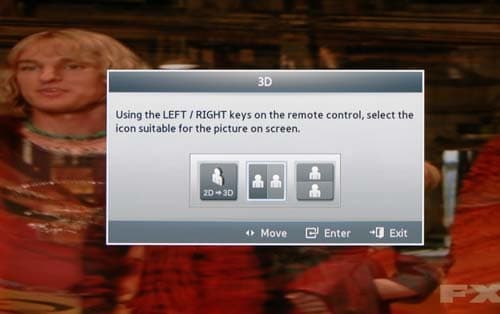
Some of the options in the 3D menu
3D Black & White
{{section_header}}{{section.name}}{{/section_header}}
Typically a TV's 3D mode throttles it's peak brightness, and our testing showed the UN46C7100 was no different. In our testing, we found the TV's peak brightness fell from 365.74 to 64.85 candelas per square meter (cd/m2), a significant drop. The black level also fell—to a deep 0.06 cd/m2. While that's a great black level, it wasn't enough to save the TVs' contrast ratio, which ended up around 1080:1. This isn't particularly good, but it's also not the worst we've seen, including strictly 2D sets.

3D Color
{{section_header}}{{section.name}}{{/section_header}}
The TVs color temperature was pretty consistent. It wandered slightly on the warm side of things, but was barely noticeable. The 3D mode didn't do much harm on this test.
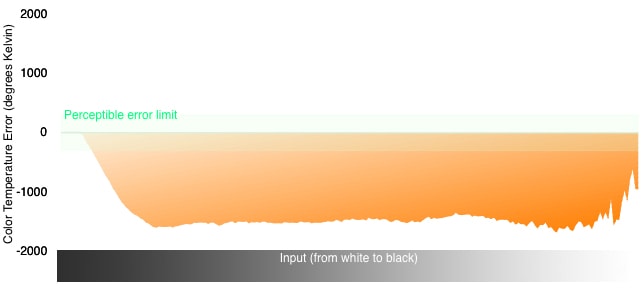
3D Crosstalk
{{section_header}}{{section.name}}{{/section_header}}
The 3D does create a lot of crosstalk, which lead to the effect We found the TV did suffer from a fair amount of crosstalk, which is when the images meant for your left eye aren't totally separated from the images intended for your right eye and vice versa. This can help lead to a breakdown in the 3D effect and can also have a negative effect on color representation and luminance.
The worst crosstalk occurred when one eye is being fed black and the other is being fed white, or another bright color. The result is a significant dimming of the non-black color, which can ruin the 3D effect. Crosstalk is also responsible for some images looking tripled (the actual image, and a faint duplicate slightly to its left and right). The crosstalk was a bit worse than what we've seen on other Samsung 3D HDTVs, such as the UN46C8000.
3D Calibration
Since the active shutter glasses change how you view the screen, we calibrate the TV for 3D performance separately.
| Setting | Default | Calibrated |
| Picture Mode: | Movie | |
| Backlight | 10 | 20 |
| Brightness | 45 | 42 |
| Sharpness | 20 | 0 |
| Contrast | 90 | 88 |
3D Modes & Controls
The UN46C7100 doesn't give users many controls for tweaking the 3D settings of a Blu-ray source. You're limited to just the Standard and Movie picture modes, and your only real option is swapping the frames that show up in the left and right eye. With a non-Blu-ray source, you have far more options.
2D to 3D Conversion
When this feature is on, the TV uses its sorcery to try and convert 2D video to 3D, via fancy processing. The effect was hit or miss. We barely saw any 3D effect on normal TV; news channels and other content that uses overlaid information will get a bit of a pop to it. Still photos were able to hold a mild 3D effect, but that's a really short-lived novelty.

Other 3D modes
The TV also supports side by side, top & bottom, line by line, vertical strip, checker board and frequency 3D formats. These formats wouldn't be used when you're watching a 3D Blu-ray disc, but some broadcasters might use them for sending 3D signals over the air.
3D Glasses
{{section_header}}{{section.name}}{{/section_header}}
We thought the Samsung's 3D glasses were pretty average in terms of comfort. They're like putting on a pair of heavy, ill-fitting sunglasses: they feel a bit off, but not necessarily uncomfortable. particularly comfortable, but they certainly weren't prohibitively uncomfortable. They felt like a cheap pair of sunglasses: they were big and not necessarily heavy, but we were definitely aware they were on our nose. We tried the 3D glasses on with and without a set of prescription glasses, but it didn't seem to affect comfort level.
As with all 3D glasses we've tested, the active shutter can be somewhat disorienting, cause eye strain, or just flat-out make you feel uncomfortable. They take some getting used to.
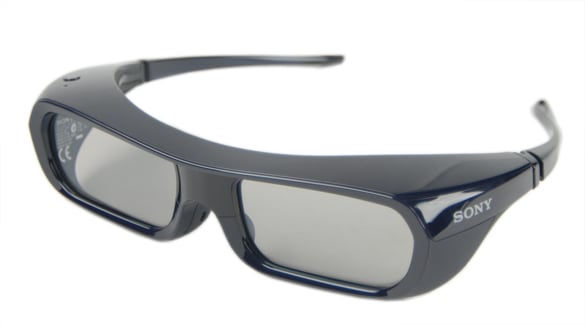
Yes, you will look like a dork with these on
Formats
{{section_header}}{{section.name}}{{/section_header}}
The Samsung UN46C7100 has a native 1080p (1920 x 1080) display, and supports all types of NTSC content.
Viewing Angle
{{section_header}}{{section.name}}{{/section_header}}
The Samsung UN46C7100 has a terrible viewing angle. Honestly, it's one of the worst we've seen. Perhaps this has something to do with the 3D display screen requirements – we're not sure about that. Either way, you'll want to make sure that your TV watchers are seated directly in front of the screen.

Reflectance
{{section_header}}{{section.name}}{{/section_header}}
When confronted with a light from straight-on, the Samsung UN46C7100 exhibits the oddly distracting effect of creating multiple, rainbow-colored reflections. They fan out from the light in a diamond-like pattern. Fortunately, the light really does have to be at a dead-on angle. Anything else tends to appear as a minor distraction.
Video Processing
{{section_header}}{{section.name}}{{/section_header}}
The Samsung UN46C7100 has many, many video processing features, and you'll need to spend a lot of time with the manual and the TV's menu system to understand them all. Here's our take, in the chart below.
Calibration
{{section_header}}{{section.name}}{{/section_header}}
The Samsung UN46C7100 offers the best color performance in Movie mode. From there, we made the following adjustments. If a feature is not listed below, assume that we disabled it.

All of our calibration is done in conjunction with the DisplayMate software.
](http://www.displaymate.com/)
Video Modes
{{section_header}}{{section.name}}{{/section_header}}
There are four video modes on the Samsung UN46C7100.
Ergonomics & Durability
{{section_header}}{{section.name}}{{/section_header}}
The remote control that ships with the Samsung UN46C7100 is very cool looking, there's no doubt about that. But this was our third time around using the same remote, and we were surprised to find ourselves tired and reluctant to use it. The problem is that the unibody design makes it very difficult to operate without constantly looking down to make sure our finger is in the right place. The little ridges positioned all over the surface are helpful, but not as much as a series of distinctly shaped buttons would be, like to kind you find on almost any remote.
Button Layout & Use
{{section_header}}{{section.name}}{{/section_header}}
The button grouping is sensible, at least. The menu controls are in the center, buffeted by the numeric buttons at the top and the some assorted function buttons closer to the bottom.
Programming & Flexibility
{{section_header}}{{section.name}}{{/section_header}}
The remote can be used to control some other Samsung AV devices, but is not programmable as a universal remote.
Connectivity
{{section_header}}{{section.name}}{{/section_header}}
Input Ports (5.0)
The Samsung UN46C7100 has a very, very thin frame. As a result, the engineers had to get creative about where and how to fit the necessary ports. The result was clearly a compromise, and one that you should know about before you make a purchase. There are fewer legacy ports than most TVs, meaning just one component and one composite. And nearly all the ports require a proprietary adapter (included) that you'll probably have a hell of a time trying to replace if it gets lost or broken.

The ports are arranged in an L-shape around the back of the TV. It's a tight fit, and not all types of HDMI cables will fit. Samsung sure isn't making it easy.

Output Ports (2.0)
The Samsung UN46C7100 has an analog audio output and a digital audio out. This is standard for most HDTVs.
Other Connections (7.0)
The has an ethernet LAN port for streaming content and DLNA home theater connections. Either of two USB ports can also accept an optional WiFi dongle.
Media (2.0)
The Samsung UN46C7100 has two USB ports that can be used to play back photos, video, and music. Either port accepts USB thumb drives, and one of them can interface with full-sized hard drives.
{{product.manufacturer_specs['Connectivity Tour Image 3']}}
Placement
{{section_header}}{{section.name}}{{/section_header}}
All the ports on the Samsung UN46C7100 are located on the back of the TV, in an L-shape. Half face downward, and half face the left side. Because they hug so close to the TV panel getting wires to fit can be tricky. Fortunately, the TV can swivel on its base, making everything a little easier to access.
Audio Quality
{{section_header}}{{section.name}}{{/section_header}}
One of the upgrades the C71000 series offers over the C7000 series is an SRS Surround Sound (at least, it would appear so based on Samsung's specs). It's hard to tell if it was substantially different from the 55-inch C7000 series we reviewed, which a "Tru Surround Sound" feature. Both features have the same end, which is trying to emulate the effect of being surrounded by speakers when there are really just the two in the TV.
The overall effect was pretty good, for a TV. It lacks the bass response of a dedicated 5.1 channel sound system, but the floors did get shaking, which is a rarity in the TVs we review. The menu gives you a 5-channel equalizer, or you choose a series of preset audio modes.
Menu Interface
{{section_header}}{{section.name}}{{/section_header}}
The Samsung UN46C7100 has the same menu as most of the 2010 Samsung TVs. It's well organized and easy to see where most of your options are. The interface with the remote, however, slows down the experience. As we've mentioned elsewhere in the review, the unibody surface of the remote makes it difficult to use the remote without constantly looking down at it.

A couple of the sub-menus can be confusing, because there's a "Picture Options" sub-menu and an "Advanced Settings" sub-menu, both containing similar types of features. There's no rhyme or reason we can see for what constitutes the split.

Instruction Manual
{{section_header}}{{section.name}}{{/section_header}}
The instruction manual that comes with the Samsung UN46C7100 is thorough and useful, with an index and a table of contents. You can find the Samsung UN46C7100's manual online here.

A manual for so many TV models, they have to be further categorized by type.
Internet Features
{{section_header}}{{section.name}}{{/section_header}}
The playing field for streaming content and internet features is slowly being leveled. Earlier in 2010, Sony had a strong lead over all the other TV manufacturers. But now in September, nearly every TV with an ethernet jack has a decent selection of video and audio selections. Samsung has Netflix, which is really the most important, along with many, many more. For the full run-down, read our special article that compares all the streaming content packages from different manufacturers.
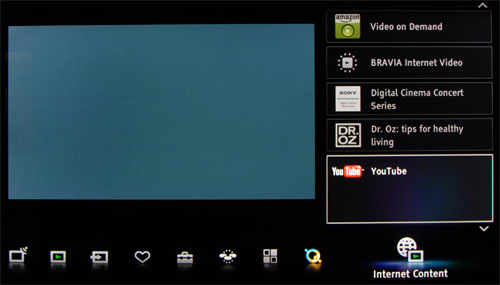
Local Media Playback
{{section_header}}{{section.name}}{{/section_header}}
The Samsung UN46C7100 can play back photos from a USB thumb drive or a full-sized hard drive via the two USB ports. When you plug your device it, the TV will first ask you if you want to access photos, videos, or music. Make your choice. If you pick photos, you'll get a screen like you see below. You can view photos one by one, or create slideshow, complete with music from the same storage device.

Music and video clip playback is similar to the photo playback described above. You can access media from USB thumb drives or HDDs with USB connections.
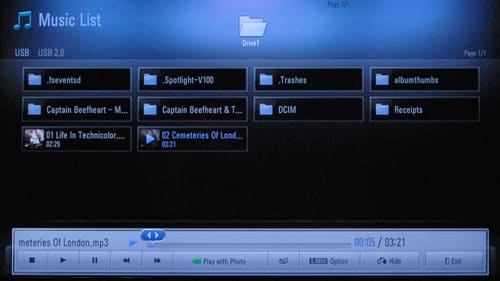
Other Media
{{section_header}}{{section.name}}{{/section_header}}
The Samsung UN46C7100 can connect to other Samsung AV devices that have the AllShare feature.
Power Consumption
{{section_header}}{{section.name}}{{/section_header}}
The Samsung UN46C7100 showed a good, conservative power consumption when we tested it. As an LCD TV, you can raise and lower the backlight to adjust not only the brightness, but the power draw, as well. Our testing results are in the table below.
The chart below shows how the Samsung UN46C7100 compares to the competition. Note that the plasma Panasonic requires much more power than the LCD TVs.
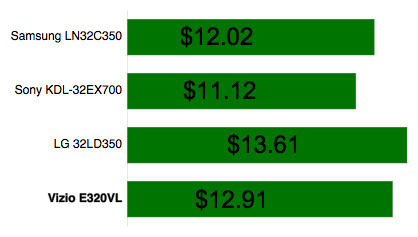
Value Comparison
{{section_header}}{{section.name}}{{/section_header}}
The Samsung UN46C8000 is one tier up from the C7000 series in the Samsung LED television line-up. There's not a whole lot of difference. The C8000 series offers a different type of dynamic contrast processing, but the C7000 has a version, as well. The C8000 panel sits on a four-legged pedestal rather than a rectangular base. The C8000 is also marginally slimmer than the C7000. Both display 3D. In terms of performance, they're virtually identical. Take your pick. They're both great TVs.
Blacks & Whites
{{section_header}}{{section.name}}{{/section_header}}
The Samsung UN46C7100 performed almost identically to the Samsung UN46C7000 in black level, peak brightness, and contrast ratio. Samsung professes that the C8000 series should have a better contrast ratio, but that's only due to an active dimming feature that we disable for testing (because it produces skewed results).

Color Accuracy
{{section_header}}{{section.name}}{{/section_header}}
The color performances between the two Samsungs was also similar. The UN46C7100 showed a slightly better consistency in color temperature.
Motion
{{section_header}}{{section.name}}{{/section_header}}
The Samsung UN46C7100 and the UN46C8000 were virtually identical in terms of motion performance. Both have an excellent motion smoothing feature, but beware how they can make film-based content appear.
Viewing Effects
{{section_header}}{{section.name}}{{/section_header}}
The Samsung UN46C7100 and UN46C8000 both have terrible viewing angles of 22 degrees or less.
Connectivity
{{section_header}}{{section.name}}{{/section_header}}
The Samsung UN46C7100 and UNC8000 are bath very thin televisions. As such, the array of ports is quite different from most TVs. Normal jacks, apparently, would have taken up too much room, so Samsung has replaced them with a series of proprietary jacks that require proprietary adapters. The TV comes with a complete set of adapters, but good luck trying to replace them if they get lost or stolen.
Value Comparison
{{section_header}}{{section.name}}{{/section_header}}
The Panasonic TC-P50VT20 is a plasma display, which offers distinct advantages and disadvantages over LCD. The viewing angle is much better, and in this particular TV, we thought the motion performance and 3D experience were the best in its class. However, some people feel that plasma displays don't appear as sharp as comparably priced LCDs. The TC-P50VT20 also showed a particular weakness in producing a bright enough image. Overall, we would choose the Panasonic if you really plan on taking advantage of the 3D feature, because its performance is more immersive and less prone to crosstalk. Also, if the intended room is wide and shallow, the wider viewing angle will come in handy. For most other purposes, the Samsung is a great TV that looks cool in your living room and has a slightly sharper picture.
Blacks & Whites
{{section_header}}{{section.name}}{{/section_header}}
The Panasonic, as a plasma display, offers a much deeper black level than the LCD TVs in the comparison pool. However, the peak brightness was particularly weak, which made for an overall disappointing contrast ratio.

Color Accuracy
{{section_header}}{{section.name}}{{/section_header}}
The Panasonic TC-P50VT20 did not quite match up to the Samsung UN46C7100 in terms of color performance. The Samsung offers a more consistent color temperature and slightly smoother color curves.
Motion
{{section_header}}{{section.name}}{{/section_header}}
The Panasonic was tough to beat on motion performance. We loved its smoothness and lack of major artifacts from objects in motion, even against a high contrast background. It's likely one of the things that helped make it the most immersive 3D experience.
Viewing Effects
{{section_header}}{{section.name}}{{/section_header}}
The Panasonic TCP50VT20 is a plasma display, and as such it offers a far wider viewing angle that any of the LCD TVs.
Connectivity
{{section_header}}{{section.name}}{{/section_header}}
Panasonic doesn't try so hard to make the slimmest TV frame, so they have fewer problems trying to squeeze in ports. As you can see from the chart below, the Panasonic is the best equipped.
Value Comparison
{{section_header}}{{section.name}}{{/section_header}}
The Sony KDL-46HX800 is a 3D-_ready_ TV, meaning you still have to buy glasses and a 3D sync transmitter to watch 3D. Now, this may become the norm for high-end TVs in the near future, but it feels like a squeeze to lay down more money for an already expensive TV. Based on the simple fact that the Samsung C71000 comes with all the necessary equipment, including glasses (a rare inclusion) for the same price, it's a no-brainer. This is especially true when you consider that the performances are very similar, and the Sony's only distinct advantage is more streaming video offerings. It's a price war, pure and simple, and Samsung seems to be willing to dig deeper than anyone else.
Blacks & Whites
{{section_header}}{{section.name}}{{/section_header}}
The Sony was able to achieve a slightly deeper black level than the Samsung UN46C7100. However, peak brightness was not quite as high. It all evened out, for the most part, in offering comparable contrast ratios.

Color Accuracy
{{section_header}}{{section.name}}{{/section_header}}
The Samsung UN46C7100 has a more consistent color temperature than the Sony KDL-46HX800. The RGB color curve tests were a draw. Both are strong performers.
Motion
{{section_header}}{{section.name}}{{/section_header}}
The Samsung UN46C7100 and Sony HX800 are about evenly matched for motion performance. Both offer motion smoothing features that smooth away jitters, but create a distinctly strange look to film-based content.
Viewing Effects
{{section_header}}{{section.name}}{{/section_header}}
The Sony and Samsung both have a narrow viewing angle of 22 degrees or less.
Connectivity
{{section_header}}{{section.name}}{{/section_header}}
The Sony 46HX800 is a slim TV, but not quite so slim as the Samsung UN46C7100, so it didn't need to cut as many connectivity options.
Conclusion
The Samsung UN46C7100 ($2699 MSRP) is the most aesthetically beautiful TV you can get at $2700 right now. That's probably not enough to sway you, nor should it. Just stating a fact. Let's look at the pros and cons in order to determine if this is worth your hard earned money.
On the plus side, the C71000 series includes two pairs of 3D glasses. Right off the bat, you're saving money, because most of the other 46 to 50-inch 3D TVs cost the same price without the glasses. Samsung also offers a streaming content package near or equal to the best on the market, including Netflix. Amazon, Twitter, Skype, and more. The 2D performance is excellent, and easily matches the best of what we've reviewed this year.
On the downside, the Samsung UN46C7100 is fairly expensive, and if you don't feel quite sold on the whole 3D phenomenon, we don't blame you. This TV probably won't convert you, either. It suffers from a lot of crosstalk that kills the effect. Panasonic plasmas still seem to lead in providing the richest (that is, least distracting) 3D experience. The Samsung UN46C7100 also has a very narrow viewing angle, so this may not be the best choice for wide, shallow rooms.
Overall, Samsung UN46C7100 is great TV, and Samsung is clearly willing to undercut the competition's prices to get you to buy their 3D. But do you need 3D, especially in a first-generation technology?
Model Series Comparison
{{section_header}}{{section.name}}{{/section_header}}
There are two models in the C71000 series, which varies only slightly from the C7000 series. The UN46C7100 is upgraded from the UN46C7000 with the additions of two pairs of 3D glasses, an upgraded speaker system, and a LAN port for streaming content and DLNA home networking. Strangely, the larger 55-inch model in the C7000 series does have LAN.
Photo Gallery
{{photo_gallery "Front Tour Image", "Back Tour Image", "Sides Tour Image", "Stand Photo", "Controls Photo", "Remote Control Photo", "Connectivity Tour Image 1", "Connectivity Tour Image 2", "Connectivity Extra Photo", "Menu Main Photo", "Menu 2 Photo", "Internet Features 1 Photo", "Internet Features 2 Photo", "Internet Features 3 Photo", "Local Media Playback 1 Photo", "Local Media Playback 2 Photo"}}
Ratings & Specs
{{manufacturer_specs_table}}
Meet the tester
David Kender oversees content at Reviewed as the Editor in Chief. He served as managing editor and editor in chief of Reviewed's ancestor, CamcorderInfo.com, helping to grow the company from a tiny staff to one of the most influential online review resources. In his time at Reviewed, David has helped to launch over 100 product categories and written too many articles to count.
Checking our work.
Our team is here to help you buy the best stuff and love what you own. Our writers, editors, and experts obsess over the products we cover to make sure you're confident and satisfied. Have a different opinion about something we recommend? Email us and we'll compare notes.
Shoot us an email